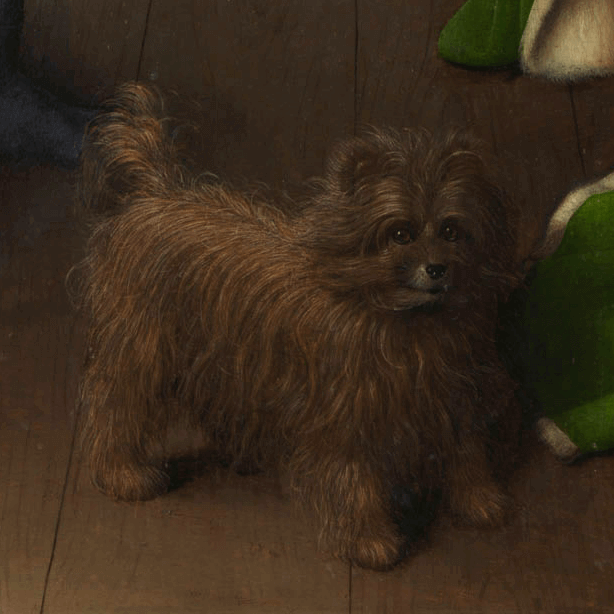Whether featured as symbols of fidelity, devotion, protection, and status, or as the subjects of portraits – some with surprisingly human-like characteristics – dogs have long fascinated artists and collectors. You can find images of dogs in contexts from prehistoric cave paintings to contemporary photographs by William Wegman, and in all cultures. Here is a selection of some favourite dog imagery in art.
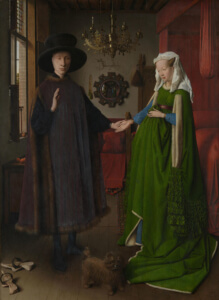

J. Van Eyck, Portrait of Giovanni Arnolfini and his wife, 1434, The National Gallery, London
In the Renaissance, the presence of dogs in paintings generally symbolised love, devotion and fidelity. In Jan van Eyck’s popular Portrait of Giovanni Arnolfini and his wife (1434), a little Griffon terrier stands between the couple at their feet. While they look at one another, the dog looks directly out at the viewer, and has generally been interpreted as a symbol of the couple’s fidelity to one another. He is not a hunting dog but rather a lap dog, possibly a gift from husband to wife, and certainly an indication of the couple’s wealth, status, and position in society.
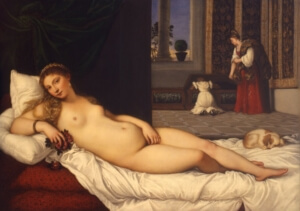

Titian, Venus of Urbino, 1534, Galleria degli Uffizi, Florence
Scholars have attached similar meaning to the small brown and white dog in Titian’s Venus of Urbino, sleeping next to the reclining nude goddess. Despite the sensuality of the figure, which may be an allegorical marriage portrait, the fact that the dog remains asleep has been taken to mean that the intended viewer is the woman’s husband – and thus, in this context, admiration of her is permitted.
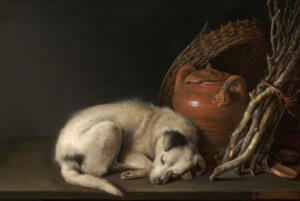

G. Dou, Dog at rest, 1650, Museum of Fine Arts, Boston, MA
Two centuries later, Leiden painter and Rembrandt pupil Gerrit Dou made a sleeping puppy the central subject of a small painting (1650). It is unique in Dou’s oeuvre – only one other animal still life by the artist is known – and Dou has painstakingly described every detail of the scene, from the dog’s fur and wet nose, to the light reflected on the terracotta jug behind it, to the rough texture of the bundle of kindling sticks. As to the meaning behind the scene – while it is apparently inspired by Rembrandt drawings and etchings of a similar subject, the same dog appears in the right-hand corner of another painting by Dou, and may well have been a beloved family pet. This painting was part of the Van Otterloo bequest to the Museum of Fine Arts in Boston and is now one of the museum’s most popular works.
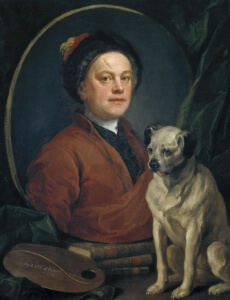

W. Hogarth, The painter and his pug, 1745, Tate Gallery, London
Although portraits of individual dogs were unusual in Dou’s time, they had become far more common by the time William Hogarth painted the self-portrait The Painter and his pug (1745), giving his dog, Trump, equal billing in the title. While the artist appears only in the form of his portrait, Trump appears as though from life, and apparently paying the portrait behind him little heed.
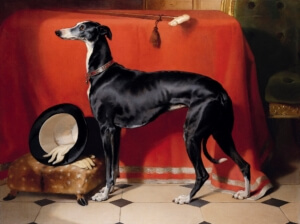

Sir E. Landseer RA, Eos, 1841, The Royal Collection, UK
Royal dogs had their moment as well. Among the most famous dogs painted by Sir Edwin Landseer, known as a consummate painter of animals and of dogs in particular, is his Eos (1841). Eos was Prince Albert’s favourite greyhound, and accompanied her master when he first arrived in England in 1840 to marry Queen Victoria. This elegant portrait, in which Eos stands guarding Prince Albert’s black silk top hat and gloves, was commissioned by the Queen as a Christmas gift for her beloved husband; according to her diary entry, Albert was ‘quite delighted’ with the painting.
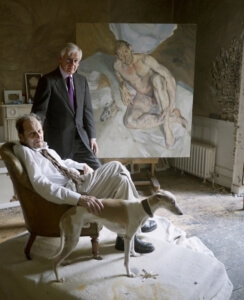

Lucian Freud and William Acquavella with Eli, 2011, photograph by David Dawson
Equally devoted to his dogs, whippets Pluto and Eli, was the great 20th century painter Lucian Freud. They appear in both leading and supporting roles, in oil paintings and in etchings, and impacted Freud’s view of his human subjects. He explained: ‘I’m really interested in people as animals….Part of my liking to work from them naked is for that reason…I like people to look as natural and as physically at ease as animals, as Pluto my whippet.’ Freud’s last painting, which remained unfinished at his death in 2011, featured his whippet Eli alongside model and studio assistant David Dawson.
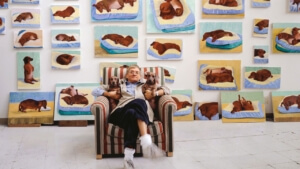

David Hockney and his dogs, photograph by Richard Schmidt
To end, we have David Hockney’s paintings of his beloved dachshunds Stanley and Boogie. They inspired Hockney’s 1995 show Dog Days, which featured 45 paintings of the two in various poses. Hockney was far from the first artist to find inspiration in the dachshund: Andy Warhol was known to bring his dachshund, Archie, to restaurants, hiding him under his napkin; while Picasso drew his dachshund, Lump, as a single, sinuous line. Earlier still, Giacomo Balla’s Futurist masterpiece Dynamism of a Dog on a Leash (1912) reduces a sausage dog to a blur of scampering legs. As Hockney explained, ‘They’re like little people to me.’ No wonder he, and so many before him, have found them as inspiring to paint as human subjects.
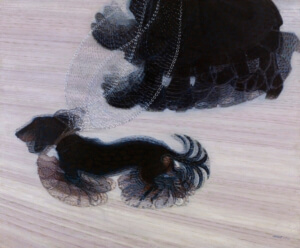

G. Balla, Dynamism of a Dog on a Leash, 1912, Albright-Knox Art Gallery, Buffalo, NY


